|
January - August: |
|
ATY - M
Primary coverts are an irregular mix of black
(fresh), and worn, retained adult feathers OR
are uniformly black. Iris deep red. Forehead and
crest red. The malar region has a distinct red
stripe.
|
|
|
|
|
ATY - F
Primary coverts are an irregular mix of black
(fresh), and worn, retained adult feathers OR
are uniformly black. Iris deep red. Forehead
blackish to olive-brown, contrasting with the
red crest. The malar region has no red. |
|
|
|
|
TY - M
Outer few primary coverts replaced (black), all
other retained primary coverts pale brown.
Forehead and crest red. The malar region has a
distinct red stripe. |
|
|
|
|
TY - F
Outer few primary coverts replaced (black), all
other retained primary coverts pale brown.
Forehead blackish to olive-brown, contrasting
with the red crest. The malar region has no
red. |
 |
 |
|
|
SY - M
Primary coverts uniformly brown and contrast
with the rest of the wing. Forehead and crest
red. The malar region has a distinct red
stripe. |
|
|
|
|
SY - F
Primary coverts uniformly brown and contrast
with the rest of the wing. Forehead blackish to
olive-brown, contrasting with the red crest.
The malar region has no red. |
|
|
|
|
|
September - December: |
|
ASY - M
Primary coverts are an irregular mix of black
(fresh), and worn, retained adult feathers OR
are uniformly black. Iris deep red. Forehead and
crest red. The malar region has a distinct red
stripe. |
|
|
|
|
ASY - F
Primary coverts are an irregular mix of black
(fresh), and worn, retained adult feathers OR
are uniformly black. Iris deep red. Forehead
blackish to olive-brown, contrasting with the
red crest. The malar region has no red. |
|
|
|
|
SY - M
Outer few primary coverts replaced (black), all
other retained primary coverts brown. Forehead
and crest red. The malar region has a distinct
red stripe. |
|
|
|
|
SY - F
Outer few primary coverts replaced (black), all
other retained primary coverts brown. Forehead
blackish to olive-brown, contrasting with the
red crest. The malar region has no red. |
|
|
|
|
HY - M
Primary coverts brown, contrasting with the rest
of the wing. Iris gray/brown. Forehead and
crest red. The malar region has a distinct red
stripe. |
|
|
|
|
HY - F
Primary coverts brown, contrasting with the rest
of the wing. Iris gray/brown. Forehead
blackish to olive-brown, contrasting with the
red crest. The malar region has no red. |
 |
 |
|
|
Ageing and sexing details:
ATY malesí
foreheads and crests are red. The malar region has a distinct red
stripe, and the iris is deep red.
Primary coverts are an irregular mix of black (fresh), and
brown (worn) feathers OR are uniformly black. The secondaries are
either uniformly adult with relatively fresh tertials, OR have 1-4 older
adult feathers (often not symmetrically in both wings) that contrast
only slightly with replaced feathers. Note: ATYs with isolated,
retained juvenal primary coverts or with 3 generations of primary
coverts (sequentially replaced), may be aged 4Ys, but more study is
needed.
Tails are not terribly useful for ageing or sexing woodpeckers.
RETURN TO AGE/SEX OVERVIEW
ATY femalesí foreheads are blackish to olive-brown, contrasting with the
red crest. The
malar region has no red, and the iris is a deep red.
Primary coverts are an irregular mix of black (fresh), and
brown (worn) feathers OR are uniformly black. The secondaries are
either uniformly adult with relatively fresh tertials, OR have 1-4 older
adult feathers (often not symmetrically in both wings) that contrast
only slightly with replaced feathers. Note: ATYs with isolated,
retained juvenal primary coverts or with 3 generations of primary
coverts (sequentially replaced), may be aged 4Ys, but more study is
needed.
Tails are
not terribly useful for ageing or sexing woodpeckers.
RETURN TO AGE/SEX OVERVIEW
TY malesí foreheads and crests are red. The malar region has
a distinct red stripe.
The outer few primary coverts are replaced
(black). All other retained primary coverts are pale brown. The back
and wing coverts are uniformly black, and the secondaries are either
uniformly adult or occasionally 1-4 juvenal feathers are retained
through s1-s5 (often symmetrically in both wings). These should
contrast markedly with replaced feathers. Some intermediates may occur
that are extremely difficult to age. These should be aged ASY.
Tails are
not terribly useful for ageing or sexing woodpeckers, though can help
differentiate between Downy and Hairy Woodpeckers. The Downy Woodpecker
has black in the outer rectrix while the Hairy rarely does.
RETURN TO AGE/SEX OVERVIEW
TY femalesí foreheads are blackish to olive-brown, contrasting with the
red crest. The malar region has no red.
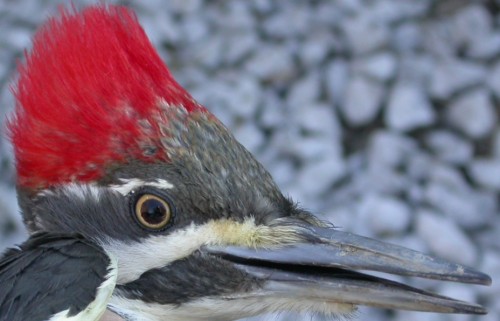
Photo by Marcel Gahbauer, April 2006
The outer few primary coverts are replaced
(black). All other retained primary coverts are pale brown. This is
shown in the photo below, where the 2 outer primary coverts are fresher
than the others. The back and wing coverts are uniformly black, and the
secondaries are either uniformly adult or occasionally 1-4 juvenal
feathers are retained through s1-s5 (often symmetrically in both
wings). These should contrast markedly with replaced feathers, as seen
in the photo below. Some intermediates may occur that are extremely
difficult to age. These should be aged ASY.
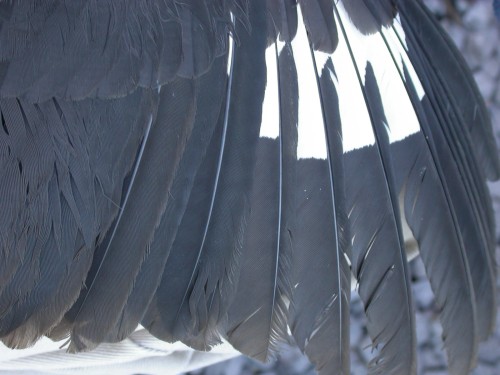
Photo by Marcel Gahbauer, April 2006
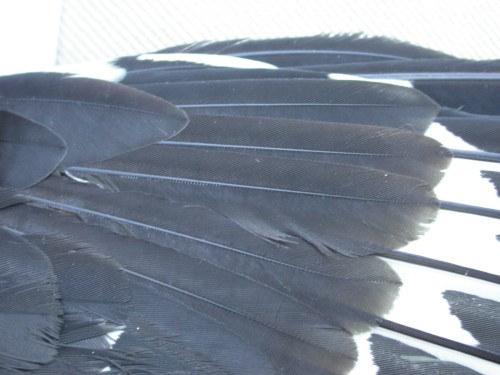
Photo by Marcel Gahbauer, April 2006
Tails are not terribly useful for ageing or sexing woodpeckers.
RETURN TO AGE/SEX OVERVIEW
SY malesí foreheads and crests are red. The malar region has
a distinct red stripe, and the iris is grayish or brownish.
Primary coverts are uniform and paler brown than the rest of
the wing. The back feathers and replaced inner wing coverts contrast
with the browner, retained outer wing coverts. The secondaries are
either uniform in colour or 1-3 may occasionally be fresher. Caution:
SYs can resemble ATYs with uniform secondaries and primary coverts.
Look for retention of juvenal characteristics: a larger, more rounded
p10.
Tails are not terribly useful for ageing or sexing
woodpeckers, but SY birds can sometimes have very pointed rectrices that
may support other plumage characteristics.
RETURN TO AGE/SEX OVERVIEW
SY femalesí foreheads are blackish to olive-brown,
contrasting with the red crest. The malar region has no red, and the
iris is grayish or brownish.
Primary coverts are uniform and paler brown than the rest of
the wing. The back feathers and replaced inner wing coverts contrast
with the browner, retained outer wing coverts. The secondaries are
either uniform in colour or 1-3 may occasionally be fresher. Caution:
SYs can resemble ATYs with uniform secondaries and primary coverts.
Look for retention of juvenal characteristics: a larger, more rounded
p10.
Tails are not terribly useful for ageing or sexing
woodpeckers, but SY birds can sometimes have very pointed rectrices that
may support other plumage characteristics.
RETURN TO AGE/SEX OVERVIEW
ASY malesí foreheads and crests are red. The malar region
has a distinct red stripe, and the iris is deep red.
Primary coverts are an irregular mix of black (fresh), and
brown (worn) feathers OR are uniformly black. The secondaries are
either uniformly adult with relatively fresh tertials, OR have 1-4 older
adult feathers (often not symmetrically in both wings) that contrast
only slightly with replaced feathers. Note: ASYs with isolated,
retained juvenal primary coverts or with 3 generations of primary
coverts (sequentially replaced), may be aged TYs, but more study is
needed.
Tails are not terribly useful for ageing or sexing woodpeckers.
RETURN TO AGE/SEX OVERVIEW
ASY femalesí foreheads are blackish to olive-brown,
contrasting with the red crest. The malar region has no red, and the
iris is deep red.
Primary coverts are an irregular mix of
black (fresh), and brown (worn) feathers OR are uniformly black. The
secondaries are either uniformly adult with relatively fresh tertials,
OR have 1-4 older adult feathers (often not symmetrically in both wings)
that contrast only slightly with replaced feathers. Note: ASYs with
isolated, retained juvenal primary coverts or with 3 generations of
primary coverts (sequentially replaced), may be aged TYs, but more study
is needed.
Tails are not terribly useful for ageing or sexing woodpeckers.
RETURN TO AGE/SEX OVERVIEW
SY malesí foreheads and crests are red. The malar region has
a distinct red stripe, and the iris may be grayish or brownish.
The outer few primary coverts are replaced
(black). All other retained primary coverts are pale brown. The back
and wing coverts are uniformly black, and the secondaries are either
uniformly adult or occasionally 1-4 juvenal feathers are retained
through s1-s5 (often symmetrically in both wings). These should
contrast markedly with replaced feathers. Some intermediates may occur
that are extremely difficult to age. These should be aged AHY.
Tails are not terribly useful for ageing or sexing
woodpeckers, but SY birds can sometimes have pointed rectrices that may
support other plumage characteristics.
RETURN TO AGE/SEX OVERVIEW
SY femalesí foreheads are blackish to olive-brown,
contrasting with the red crest. The malar region has no red, and the
iris may be grayish or brownish.
The outer few primary coverts are replaced
(black). All other retained primary coverts are pale brown. The back
and wing coverts are uniformly black, and the secondaries are either
uniformly adult or occasionally 1-4 juvenal feathers are retained
through s1-s5 (often symmetrically in both wings). These should
contrast markedly with replaced feathers. Some intermediates may occur
that are extremely difficult to age. These should be aged AHY.
Tails are not terribly useful for ageing or sexing
woodpeckers, but SY birds can sometimes have pointed rectrices that may
support other plumage characteristics.
RETURN TO AGE/SEX OVERVIEW
HY malesí foreheads and crests are red. The malar region has
a distinct red stripe, and the iris is grayish or brownish.
Primary coverts are uniform and paler brown than the rest of
the wing. The back feathers and replaced inner wing coverts contrast
with the browner, retained outer wing coverts. The secondaries are
either uniform in colour or 1-3 may occasionally be fresher. Caution:
fresh fall HYs can resemble ASYs with uniform secondaries and primary
coverts. Look for retention of juvenal characteristics through October:
a larger, more rounded p10.
Tails are not terribly useful for ageing or sexing
woodpeckers, but HY birds can sometimes have very pointed rectrices that
may support other plumage characteristics.
RETURN TO AGE/SEX OVERVIEW
HY femalesí foreheads are blackish to olive-brown,
contrasting with the red crest. The malar region has no red, and the
iris is grayish or brownish.
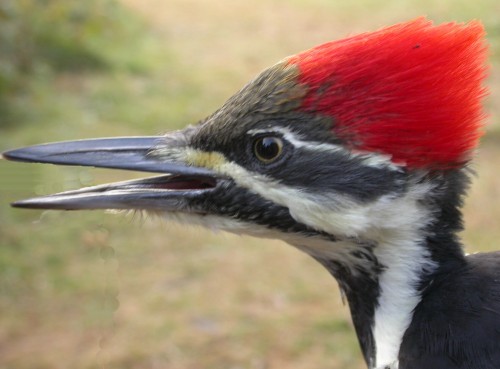
Photo
by Marcel Gahbauer, September 2004
Primary coverts are uniform and paler brown than the rest of
the wing (shown below). The back feathers and replaced inner wing
coverts contrast with the browner, retained outer wing coverts. The
secondaries are either uniform in colour or 1-3 may occasionally be
fresher. Caution: fresh fall HYs can resemble ASYs with uniform
secondaries and primary coverts. Look for retention of juvenal
characteristics through October: a larger, more rounded p10 (shown below
on the right edge of the wing).
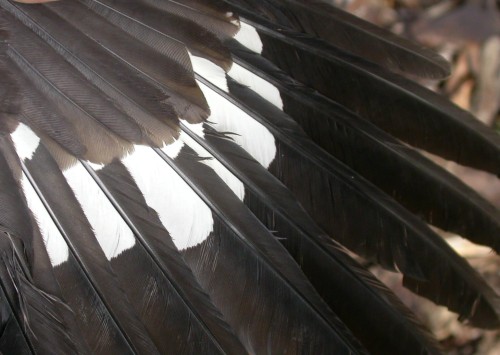
Photo by Marcel Gahbauer, September 2004
Tails are not terribly useful for ageing or sexing
woodpeckers, but HY birds can sometimes have very pointed rectrices that
may support other plumage characteristics.
RETURN
TO AGE/SEX OVERVIEW